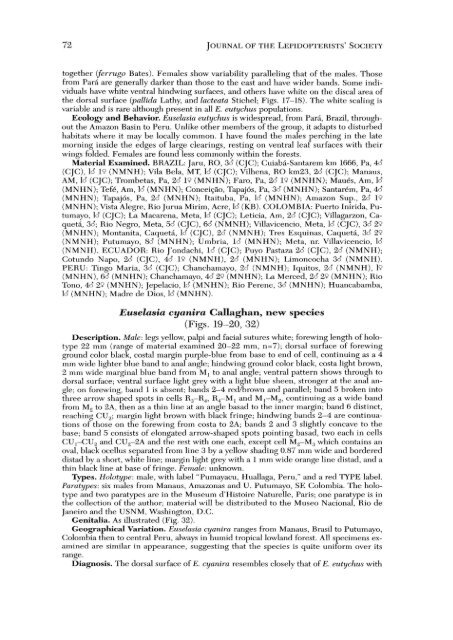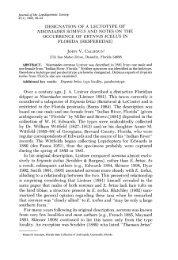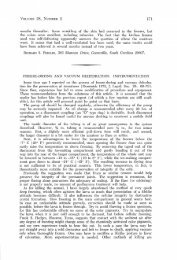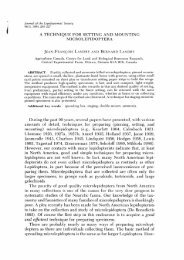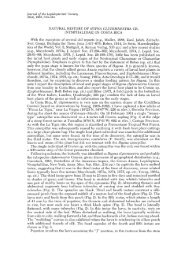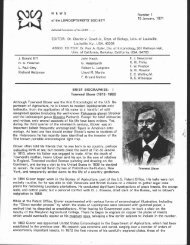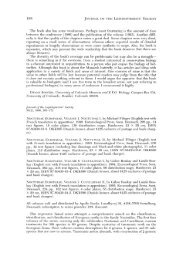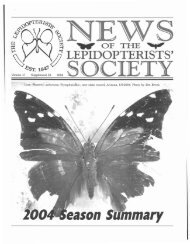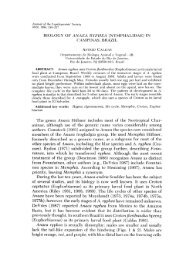A REVISION OF THE EUSELASIA ORFITA COMPLEX (RIODINIDAE ...
A REVISION OF THE EUSELASIA ORFITA COMPLEX (RIODINIDAE ...
A REVISION OF THE EUSELASIA ORFITA COMPLEX (RIODINIDAE ...
Create successful ePaper yourself
Turn your PDF publications into a flip-book with our unique Google optimized e-Paper software.
72 JOURNAL <strong>OF</strong> <strong>THE</strong> LEPIDOPTERISTS' SOCIETY<br />
together Iferrugo Bates). Females show variability paralleling that of the males. Those<br />
from Para are generally darker than those to the east and have wider bands. Some individuals<br />
have white ventral hindwing surfaces, and others have white on the discal area of<br />
the dorsal surface (pallida Lathy, and lacteata Stichel; Figs. 17-18). The white scaling is<br />
variable and is rare although present in all E. eutychus populations.<br />
Ecology and Behavior. Euselasia eutychus is widespread, from Para, Brazil, throughout<br />
the Amazon Basin to Peru. Unlike other members of the group, it adapts to disturbed<br />
habitats where it may be locally common. I have found the males perching in the late<br />
morning inside the edges of large clearings, resting on ventral leaf surfaces with their<br />
wings folded. Females are found less commonly within the forests.<br />
Material Examined. BRAZIL: Jaru, RO, 30 (CjC); Cuiaba-Santarem km 1666, Pa, 40<br />
(qC), 10 19 (NMNH); Vila Bela, MT, k1 (qC); Vilhena, RO km23, 20 (CJC); Manaus,<br />
AM, 10 (qC); Trombetas, Pa, 20 19 (MNHN); Faro, Pa, 20 19 (MNHN); Maues, Am, 10<br />
(MNHN); Tefe, Am, 10 (MNHN); ConceiC;:1io, Tapaj6s, Pa, 30 (MNHN); Santarem, Pa, 40<br />
(MNHN); Tapaj6s, Pa, 20 (MNHN); Itaituba, Pa, 10 (MNHN); Amazon Sup., 20 19<br />
(MNHN); Vista Alegre, Rio Jurua Mirim, Acre, 10 (KB). COLOMBIA: Puerto Inirida, Putumayo,<br />
10 (CIC); La Macarena, Meta, 10 (CIC); Leticia, Am, 20 (CJC); Villagarzon, Caqueta,<br />
30; Hio Negro, Meta, 50 (qC), 60 (NMNH); Villavicencio, Meta, 10 (qC), 30 29<br />
(MNHN); Montanita, Caqueta, 10 (CIC), 20 (NMNH); Tres Esquinas, Caqueta, 30 29<br />
(NMNH); Putumayo, 80 (MNHN); Umbria, 10 (MNHN); Meta, nr. Villavicencio, 10<br />
(NMNH). ECUADOR: Rio J'ondachi, 10 (qC); Puyo Pastaza 20 (qC), 20 (NMNH);<br />
Cot undo Napo, 20 (qC), 40 19 (NMNH), 2c) (MNHN); Limoncocha 30 (NMNH).<br />
PERU: Tingo Maria, 30 (CjC); Chanchamayo, 20 (NMNH); Iquitos, 20 (NMNH), 19<br />
(MNHN), 60 (MNHN); Chanchamayo, 40 29 (MNHN); La Merced, 2629 (MNHN); Rio<br />
Tono, 40 29 (MNHN); Jepelacio, 10 (MNHN); Rio Perene, 30 (MNIlN); Huancabamba,<br />
10 (MNHN); Madre de Dios, 10 (MNHN).<br />
Euselasia cyanira Callaghan, new species<br />
(Figs. 19-20, 32)<br />
Description. Male: legs yellow, palpi and facial sutures white; forewing length of holotype<br />
22 mm (range of material examined 20-22 mm, n=7); dorsal surface of forewing<br />
ground color black, costal margin purple-blue from base to end of cell, continuing as a 4<br />
mm wide lighter blue band to anal angle; hindwing ground color black, costa light brown,<br />
2 mm wide marginal blue band from M 1 to anal angle; ventral pattern shows through to<br />
dorsal surface; ventral surface light grey with a light blue sheen, stronger at the anal angle;<br />
on forewing, band 1 is absent; bands 2-4 red/brown and parallel; band 5 broken into<br />
three arrow shaped spots in cells RrR4' R4-M[ and M I-M2' continuing as a wide band<br />
from M2 to 2A, then as a thin line at an angle basad to the inner margin; band 6 distinct,<br />
reaching CU2 ; margin light brown with black fringe; hindwing bands 2-4 are continuations<br />
of those on the forewing from costa to 2A; bands 2 and 3 slightly concave to the<br />
base; band 5 consists of elongated arrow-shaped spots pointing basad, two each in cells<br />
CUC CU2 and CUz-2A and the rest with one each, except cell M2- M3 which contains an<br />
oval, black ocellus separated from line 3 by a yellow shading 0.87 mm wide and bordered<br />
distad by a short, white line; margin light grey with a 1 mm wide orange line distad, and a<br />
thin black line at base of fringe. Female: unknown.<br />
Types. H%type: male, with label "Pumayacu, Huallaga, Peru," and a red TYPE label.<br />
Paratypes: six males from Manaus, Amazonas and U. Putumayo, SE Colombia. The holotype<br />
and two paratypes are in the Museum d'Histoire Naturelle, Paris; one paratype is in<br />
the collection of the author; material will be distributed to the M useo Nacional, Rio de<br />
Janeiro and the USNM, Washington, D.C.<br />
Genitalia. As illustrated (Fig. 32).<br />
Geographical Variation. Euselasia cyanira ranges from ManaHS, Brasil to Putumayo,<br />
Colombia then to central Peru, always in humid tropical lowland forest. All specimens examined<br />
are similar in appearance, suggesting that the species is quite uniform over its<br />
range.<br />
Diagnosis. The dorsal surface of E. cyanira resembles closely that of E. eutychus with


